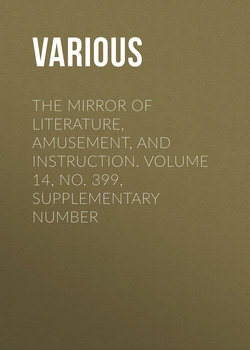Читать книгу The Mirror of Literature, Amusement, and Instruction. Volume 14, No. 399, Supplementary Number - Various - Страница 3
Friendship's Offering
ОглавлениеWe believe the editor of the present volume to be Mr. Thomas Pringle, of whose taste and fitness for the task, we spoke in our "Spirit of the Annuals" for 1829. It contains five or six striking prose articles, and, we think, fewer poetical pieces than the former volume. Among the tales entitled to special mention, as evincing considerable talent and more than the ordinary interest of mere sketches—are Il Vesuviano, a Neapolitan Story—the Voyage Out, by Mrs. Bowdich—the Lover's Leap, a Highland Legend, by Leigh Ritchie—a tale of the White Bristol, (30 pages) from the powerful pen of Mr. Banim—the Fords of Callum, by the Ettrick Shepherd—Mourad and Euxabeet, a Persian Tale, by Mr. Fraser—and Whatever betide—for the right, a tale of Old London—the titles of which will give the reader some idea of the rich and varied contents of the prose department. The Outline of a Life, by Mr. Kennedy has all the "fitful fancy" of his earlier productions, but the piece selected by us for quotation, is
LUCIFER
By J.A. St. John. 3
In an ancient chronicle of Arezzo, which still remains in manuscript in the church of St. Angelo, in that city,4 there is found the very extraordinary story of the painter Spinello Aretino, to which Lanzi alludes briefly, in his History of Painting in Italy. No farther notice has, I believe, been taken of it by any other writer whatever, although it appears to me to be singularly well calculated to gratify or to excite the curiosity of those who love to pry into the mysteries of human nature, and to mark the strange avenues by which mortals sometimes approach the gates of death.
When Spinello first arrived at Arezzo, he took lodgings in the house of an artist, who, although he possessed no great share of genius, had contrived to amass considerable wealth. This artist was no other than Bernardo Daddi, whose son, also named Bernardo, afterwards became the pupil of Spinello, and almost eclipsed his father's reputation. Besides this son, Bernardo had several other children, and among the rest a daughter named Beatrice, then just verging upon womanhood. With this daughter it was to be expected that Spinello would immediately be in love; but our young artist had left behind him, in his native village, a charming girl, to whom he was in a manner betrothed; and he was the last man in the world to look upon another with a wandering heart. He, therefore, lived in the same house, and ate at the same table with Beatrice, without even discovering that she was beautiful; while they who merely caught a glance of her at church, or as she moved, like a vision, along the public walk, pretended to be consumed with passion.
3
We have abridged this tale to suit our limits, though we trust not at the expense of the interest of the author. The style is rich and tender, and well suited to this class of works, although we cannot help thinking some of the details unnecessarily protracted. In the volume it occupies 22 pages.
4
Vide Catal Manuscript. Sanct Ang. No. 817. 4to. Rom. 1532.
